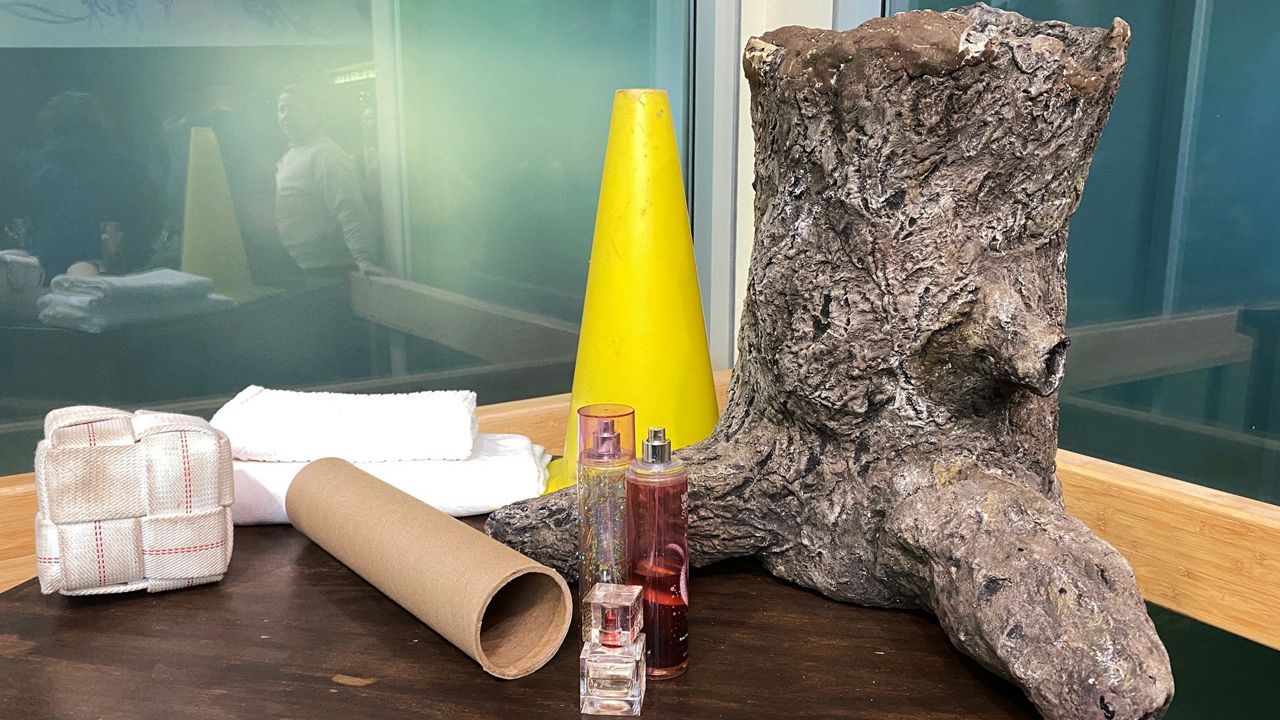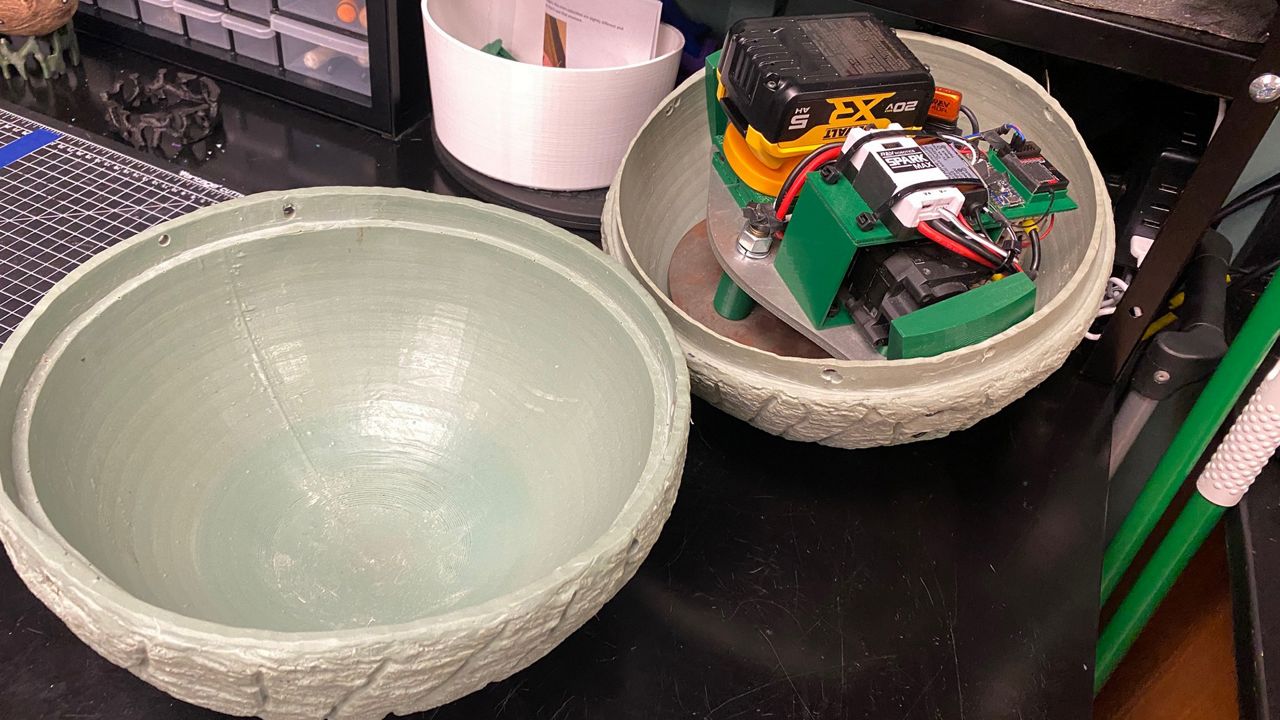KISSIMMEE, Fla. — The holiday season is underway at Disney World, but Christmas came early for a troop of western lowland gorillas at Disney’s Animal Kingdom.
What You Need To Know
- Experts say enrichment is an important part of caring for animals at Disney's Animal Kingdom
- The animal care team gets creative with the items they create for the animals, sometimes using simple items to make a device
- A water jug can become a feeder for warthogs, or the team can go high-tech and create a motorized cheetah ball using a 3D printer
- The enrichment is designed to encourage natural behaviors in the animals
On a cool morning earlier this month, the gorillas celebrated with dozens of brightly wrapped presents.
As they entered their habitat, they found presents on the ground. Presents in trees, requiring the gorillas to use their climbing skills to reach. Big presents, small presents.
Inside each present was an edible treat—popcorn, oats, alfalfa, hay and more. Even the wrapping paper that was ripped apart to retrieve the food was edible.
Disney did something similar for the Galapagos tortoises in October, treating them to pumpkins just in time for Halloween.
Across the way, animal keepers gave the bachelor troop of gorillas in the habitat white sheets to play with. Some used the sheets as covers for their heads — it was a chilly morning — while others used them like a picnic blanket for their food.
“For our gorillas, they’ll get these sheets to cover themselves,” said Angela Levanik, an animal keeper at the park. “They can use them to scent-mark. They can use them to hide. We can use them for medical procedures to provide them comfort, something soft while they recovery.”
The wrapped packages and the blankets are more than just gifts for the gorillas. They are part of a larger enrichment program at the park.
Animal Kingdom is home to tens of thousand of animals — big and small. And they all get some form of enrichment — activities or items that seek to trigger natural behaviors in the animals.
Putting presents around the gorilla habitat allows them to forage for food like they would in the wild, or the gorillas will use their climbing abilities to reach the presents placed in the trees.
Enriching the Animals

Animal enrichment is a big undertaking at the park, with animal care cast members in multiple departments working with each other to find new ways to keep the animals active and engaged. To do that, they have to get creative.
Levanik helps design the enrichment items given to the animals in the park. Often, enrichment can come from everyday items found across Disney World property that the team has transformed into something new. Pillowcases from the hotels, fabrics from costuming or paper towel rolls from custodial can all be used for enrichment.
“A lot of the items that we receive are either gently used or ready for the landfill,” Levanik said. “So we’re able to save them from that and we use them.”
The team has also collected old fire hoses from fire stations to make toys such as treat feeders. The hoses, which are very durable, can be woven into the shape of a cube and given to the rhinos to push around with their horns. With a little creativity, a large water jug can become a feeder for warthogs that looks like a tree stump.
“Pigs like to root, and they like to get under stumps,” she said. “This was created with a hole on top and then it has these legs that, once the food is dropped in, the pigs will push it around in the yard and root, and it will release the treats out of the arms of the stump.”
The goal is always encouraging an animal’s natural behaviors. The enrichment is good for the animals and it’s good for the environment.
“It’s fun for us, it’s fun for them," Levanik said. "And it really gives us a good feeling that we’re doing our part to provide an environment for the animals that is enriched, but also that we’re keeping a green-minded aspect of it too and not contributing to landfills.”
Embracing the Technology

Many of the enrichment items seem pretty simple — a blanket, a construction cone — but some of them can get pretty high-tech.
To create an enrichment item for the cheetahs, the Animal Kingdom team turned to technology.
Inside the science lab at Conservation Station, the early makings of an artificial coconut is being created inside a 3D printer.
“The behavior we want to draw when we’re printing out this particular enrichment device is foraging,” said Jose Dominguez, a behavioral husbandry and environmental monitoring technician at the park. “Foraging can look very different between species.”
The 3D-printed coconut was designed for the park’s gibbons, or even lemurs.
“Foraging for them looks a little bit different,” he said. “You have the gibbons with the long arms, so they brachiate — they use those arms to move through their enclosure. So we’ll print multiples of these, add hardware and then we’ll spread it out through the habitat so they have to zig-zag, brachiate from location to location, all within their enclosure.”
When the coconut is first printed it’s green, but the team always wants the enrichment to look like it’s part of the habitat. They use other materials to create textures or pigments to give it a natural look.
The printer has been used to make bamboo, durian fruit and small bird feeders. The team also created a handle for a flossing device for the gorillas.
Research is another component of creating enrichment. An idea may come from anywhere — a keeper, for example, who is looking for a particular behavior from an animal. The team will then brainstorm how to create the device.
“We’ll look at a lot of natural history videos of the animal, the species,” Dominguez said. “We’ll research the natural history of the animal and analyze what the behavior looks like and then go from there … figure out what the device needs to look like — what’s the shape of it, the material that it’s made out of, the safety precautions we need to make sure go into it.”
The time required to create an enrichment item will depend on not only the complexity of the behavior the team is trying to encourage, but also the complexity of the actual device.
Although using a 3D printer isn’t necessary for creating enrichment for the animals, but animal keepers say it’s a very useful tool for creating a variety of items — including more complex ones.
One of the most high-tech devices the team has created is a motorized ball for the cheetahs. They made it in partnership with the engineering team, which helped with creating the shell as well as the hardware inside that makes it run.
The shell was made using a 3D printer. That technology came in handy when the team had to experiment with different sizes and durability of the ball. Inside the ball is a motor on a weighted plate that allows it to roll back-and-forth.
Dominguez said the goal was to create something that the cheetahs would chase.
“With cheetahs, our focus behavior is locomotion,” he said. “So with this ball moving around, they chase after it. And if they chase after it, we’ve got locomotion and we’ve achieved our behavioral goal.”
He said the current version of the ball, version 2.0, looks very different from the first one the team created.
The first version was a smooth ball, and Dominguez said the team quickly learned that the surface would just cause the ball to spin in place in the sandy terrain. Taking what they learned from the previous attempt, the team made sure the shell of the new version of the ball had texture and grooves to give it grip.
The team is always looking for ways to improve the enrichment devices they create.
With the cheetah ball, the team hopes to eventually make it faster. Another goal is to make it automated, as the current version has to be moved manually using a controller.
“The final product is several iterations in the future,” Dominquez said.





